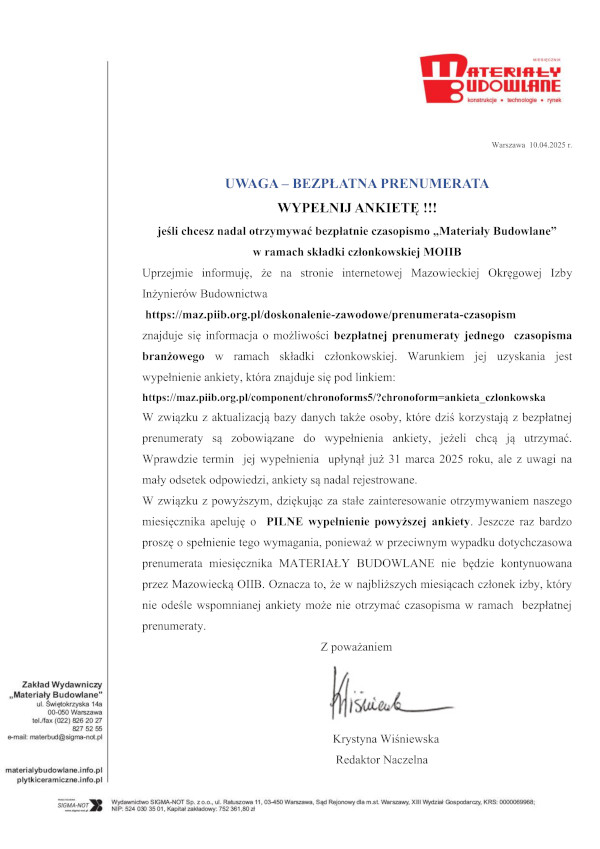Open Access (Artykuł w pliku PDF)
The acoustic properties of wooden frame buildings
dr hab. inż. Jacek Nurzyński, prof. ITB, Instytut Techniki Budowlanej
ORCID: 0000-0001-7889-4997
Adres do korespondencji: Ten adres pocztowy jest chroniony przed spamowaniem. Aby go zobaczyć, konieczne jest włączenie w przeglądarce obsługi JavaScript.
DOI: 10.15199/33.2023.09.06
Oryginalny artykuł naukowy
Streszczenie. Artykuł dotyczy właściwości akustycznych wielorodzinnych drewnianych budynków szkieletowych. Pełnowymiarowe modele stropu, ściany wewnętrznej oraz pełnej części fasady były badane w warunkach laboratoryjnych. W celu ustalenia wpływu poszczególnych elementów konstrukcyjnych badanych próbek na ich izolacyjność akustyczną pomiary wykonywano w różnych fazach montażowych. W przypadku stropu analizowano efekt zastosowania podłogi pływającej i sufitu podwieszonego. Rozpatrywano różne metody montażu sufitu – giętkie metalowe profile były znacznie bardziej efektywne niż sztywne drewniane listwy. Poprawa izolacyjności akustycznej od dźwięków uderzeniowych podłogi pływającej na badanej lekkiej konstrukcji była mniejsza w porównaniu z tradycyjnym stropem masywnym. W celu spełnienia wymagań podłoga powinna być stosowana łącznie z sufitem. W przypadku ściany wewnętrznej badano różne rodzaje szkieletu drewnianego. Ściana pojedyncza z dodatkową warstwą izolacyjną oraz całkowicie rozdzielona ściana podwójna uzyskały właściwości na poziomie odpowiednim dla budownictwa mieszkaniowego. Zastosowanie elastycznych przekładek miało decydujący wpływ na skuteczność dodatkowych warstw izolacyjnych. Wyniki badań są przydatne dla inżynierów i projektantów pracujących nad budynkami mieszkalnymi o bardzo dobrej jakości i dobrych właściwościach akustycznych.
Słowa kluczowe: drewniane budynki szkieletowe; izolacyjność akustyczna; pomiary laboratoryjne; jakość akustyczna mieszkań.
Abstract. The acoustic properties ofmulti-family wooden frame buildings were considered. Full-scale models of a floor, a dividing wall and an opaque part of a façade were examined in the laboratory. The measurements were taken at different phases of the sample’s construction to determine the contribution of their particular elements to the total sound insulation of the final structure. The acoustic effect of a floating screed and a suspended ceiling was analysed for the floor. Different assembly methods of the ceiling were investigated, and the flexible channels were significantly more effective than rigid wooden battens. The impact sound insulation improvement of the floating screed seemed lower when it was use on a lightweight floor in comparison to a traditional massive slab. The ceiling and the screed should be used together to satisfy the requirements. In the case of a dividing wall, various types of timber frames were examined, the single wall with additional insulating cladding and the totally separated double wall achieved a performance level adequate for residential use. The application of elastic dividers and resilient spacers was of critical importance for the effectiveness of the additional insulation. The results are useful for engineers and designers when working on high-quality residential buildings with good acoustic performance.
Keywords: wooden frame buildings; sound insulation; laboratory measurements; acoustic quality of dwellings.
Literatura
[1] De Geetere L, Ingelaere B. A new building acoustical concept for lightweight timber frame constructions. Proc. Forum Acust. 2014; 1–8.
[2] Quirt J, Nightingale T, King F. Guide for Sound Insulation inWood Frame Construction. 2006. https://doi.org/10.4224/20377048.
[3] Nurzyński J. Is thermal resistance correlated with sound insulation? Energy Procedia. 2015; DOI: 10.1016/j.egypro.2015.11.131.
[4] CaniatoM, Bettarello F, FerlugaA,Marsich L, Schmid C, Fausti P.Acoustic of lightweight timber buildings:Areview. Renew Sustain Energy Rev. 2017; https://doi.org/10.1016/j. rser.2017.05.110.
[5] EN ISO 10140-(1-5) Acoustics – Laboratory measurement of sound insulation of building elements – Parts1 – 5.
[6] Nowotny Ł, Nurzyński J. The influence of insulating layers on the acoustic performance of lightweight frame floors intended for use in residential buildings. Energies. 2020; DOI: 10.3390/en13051217 2020.
[7] Caniato M, Bettarello F, Fausti P, Ferluga A, Marsich L, Schmid C. Impact sound of timber floors in sustainable buildings. Build Environ. 2017; https://doi.org/10.1016/J.BUILDENV. 2017.05.015.
[8] Bradley JS, Birta J. A. On the sound insulation of wood stud exterior walls, J. Acoust. Soc. Am.. 2001; https://doi. org/10.1121/1.1416200
[9] Ljunggren F, Ågren A. Elastic Layers to Reduce Sound Transmission in Lightweight Buildings. Noise Notes. 2013; https://doi.org/10.1260/1475- 4738.12.3.3.
[10] SchollW. Sound insulation of external thermal insulation composite systems (ETICS). Deuschen Jahrestagun für Akust. DAGA 02 Bochum. 2002.
[11] Quirt JD, Warnock A, Halliwell R, Birta J. Influence of stud type and spacing, screw spacing, and sound absorbing material on the sound transmission through a double panel wall specimen. J Acoust Soc Am. 1992; https://doi. org/10.1121/1.404482.
Przyjęto do druku: 16.08.2023 r.
Materiały Budowlane 09/2023, strona 24-28 (spis treści >>)































